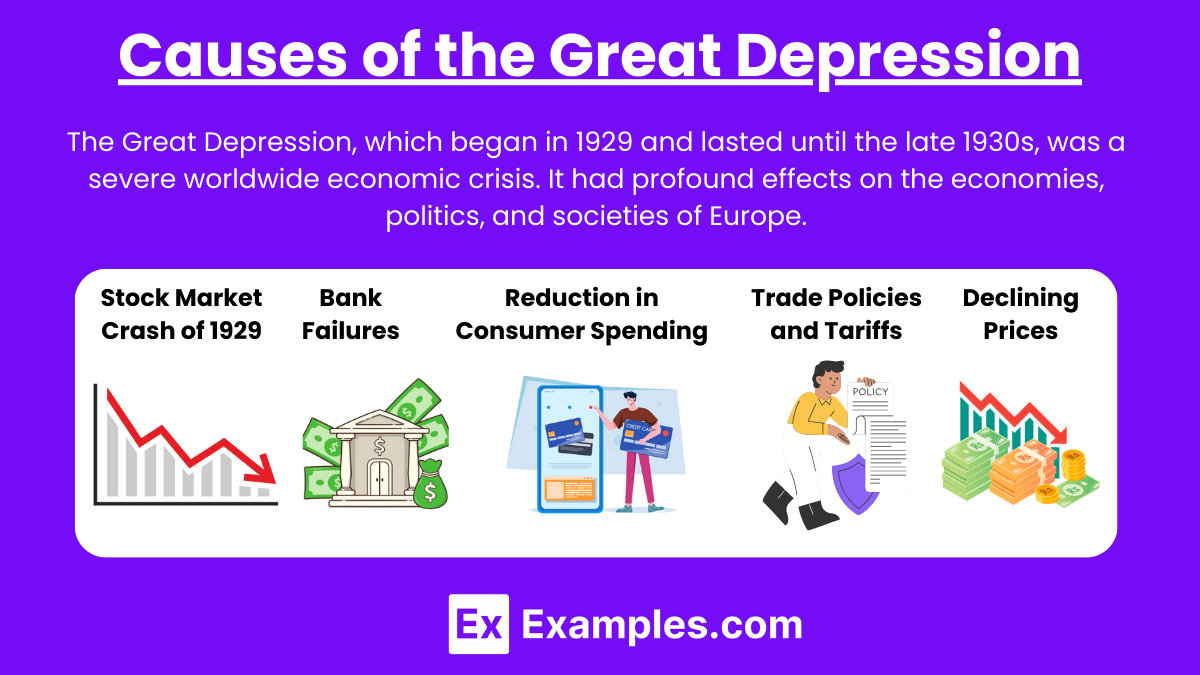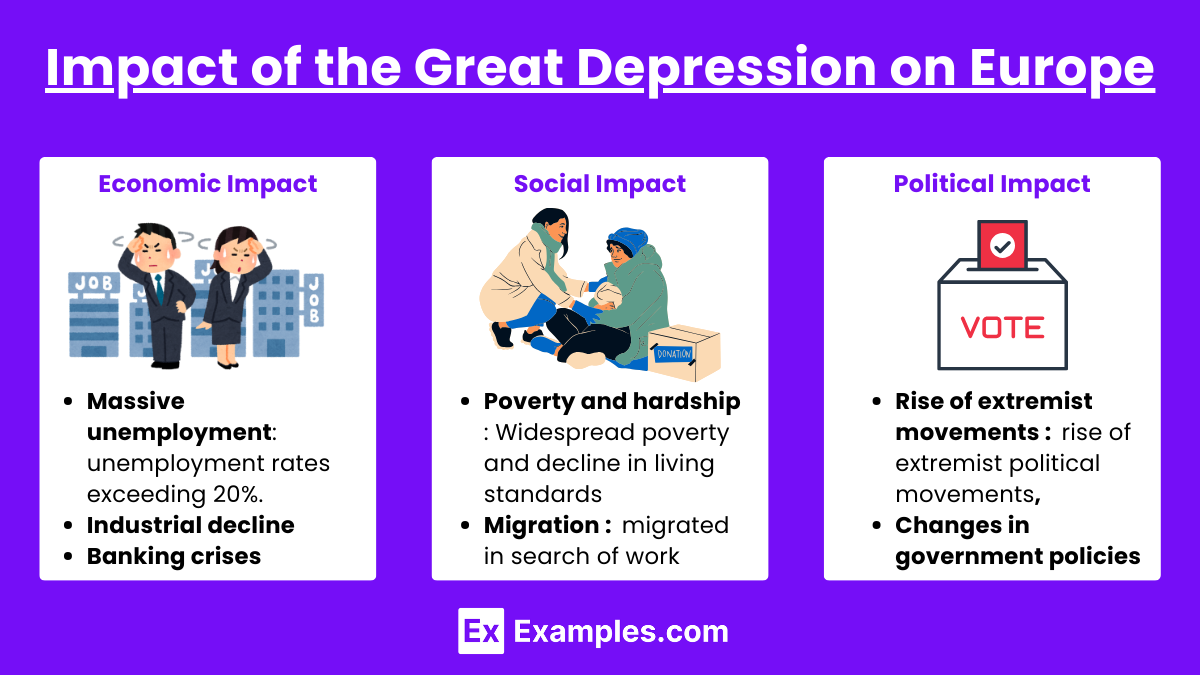The Great Depression, beginning in 1929 and lasting through the late 1930s, was a catastrophic global economic crisis. Triggered by the U.S. stock market crash, it led to widespread financial turmoil, massive unemployment, and severe social hardships. The depression profoundly affected Europe, causing industrial decline, banking failures, and political instability. In AP European History, governments responded with interventionist policies and public works programs, but the economic distress fueled the rise of extremist movements and reshaped the political landscape, leaving a lasting impact on the world.
Learning Objectives
By studying "The Great Depression" for the AP European History exam, you should aim to understand the causes, including the stock market crash and international trade issues, and their impact on European economies and societies. Recognize how the depression influenced political movements and government policies, leading to the rise of extremism and economic interventions. Additionally, comprehend the responses by various governments and the effectiveness of those measures. This knowledge will help you analyze the complex interplay between economic crises and political changes in Europe.
The Great Depression
The Great Depression, which began in 1929 and lasted until the late 1930s, was a severe worldwide economic crisis. It had profound effects on the economies, politics, and societies of Europe. Understanding its causes, impact, and responses is crucial for excelling in AP European History.
Causes of the Great Depression

Stock Market Crash of 1929:
On October 29, 1929, known as Black Tuesday, the U.S. stock market collapsed.
The crash resulted in significant financial losses and contributed to a global economic downturn.
Bank Failures:
Many banks had invested heavily in the stock market.
The crash led to a loss of confidence in the banking system, causing widespread bank failures.
In Europe, bank failures further strained already fragile economies.
Reduction in Consumer Spending:
The loss of savings and income led to a drastic reduction in consumer spending.
This reduction in demand led to further declines in production and employment.
Trade Policies and Tariffs:
The U.S. introduced the Smoot-Hawley Tariff Act in 1930, imposing high tariffs on imports.
European countries retaliated with their own tariffs, leading to a significant decline in international trade.
Overproduction and Declining Prices:
Agricultural and industrial overproduction led to falling prices.
Farmers and businesses could not sustain profitability, resulting in further economic distress.
Impact of the Great Depression on Europe

Economic Impact:
Massive unemployment: By 1932, many European countries had unemployment rates exceeding 20%.
Industrial decline: Major industries such as steel, coal, and textiles experienced significant contractions.
Banking crises: Countries like Germany and Austria faced banking collapses, exacerbating the economic crisis.
Social Impact:
Poverty and hardship: Widespread poverty and decline in living standards affected millions.
Migration: Many people migrated in search of work and better living conditions.
Political Impact:
Rise of extremist movements: Economic distress contributed to the rise of extremist political movements, including fascism and communism.
Changes in government policies: Many governments increased their intervention in the economy, implementing social welfare programs and public works projects.
Responses to the Great Depression
Government Intervention:
Keynesian economics: Many countries adopted Keynesian economic policies, advocating for increased government spending to stimulate demand.
Public works programs: Governments initiated large-scale public works projects to reduce unemployment and stimulate economic activity.
Social welfare programs: Expansion of social security systems and unemployment benefits.
International Cooperation:
Efforts to stabilize currency and trade: Countries worked together to stabilize currencies and reduce trade barriers.
Conferences and agreements: Various international conferences aimed to address the economic crisis, although with limited success.
Political Changes:
Rise of totalitarian regimes: Economic instability contributed to the rise of totalitarian regimes in Germany, Italy, and Spain.
Policy shifts: Many governments shifted towards more authoritarian and interventionist policies.
Recovery and Long-term Effects

Recovery and Long-term Effects of the Great Depression refer to the gradual process by which economies rebounded from the severe downturn of the 1930s and the enduring changes that resulted. Recovery involved slow economic improvement, influenced by factors like World War II, which spurred industrial production and job creation. Long-term effects include major reforms in banking and financial systems, increased government involvement in economic management, and the expansion of social welfare programs to protect citizens against future economic hardships.
1. Gradual Recovery
The recovery from the Great Depression was slow and uneven. Some countries began to recover in the mid-1930s, while others took longer. The outbreak of World War II eventually led to increased industrial production and employment, contributing to economic recovery.
2. Institutional Reforms
The depression led to significant changes in economic policies and institutions. Many countries reformed their banking systems and introduced financial regulations to prevent future crises.
3. Long-term Economic Policies
The Great Depression had a lasting impact on economic thought and policy. Governments became more involved in economic management, and social welfare systems were expanded to provide a safety net for citizens.
The Great Depression was a catastrophic event that reshaped the global economy and had profound political, social, and economic impacts. Understanding its causes, effects, and the responses it elicited is crucial for grasping the historical context of the 20th century and the development of modern economic policies. For AP European History, focusing on the interconnectedness of global economies and the political ramifications in Europe will provide a comprehensive understanding of this pivotal period.
Examples
Example 1 : Stock Market Crash of 1929
On October 29, 1929, known as Black Tuesday, the stock market crashed, leading to a catastrophic economic downturn. This event marked the beginning of the Great Depression, causing millions of investors to lose their savings.
Example 2 : High Unemployment Rates:
During the Great Depression, unemployment rates soared. By 1933, approximately 25% of the American workforce was unemployed, leaving many families struggling to make ends meet.
Example 3 : Bank Failures
Thousands of banks failed during the Great Depression. With bank runs and closures, many people lost their life savings, further exacerbating the economic crisis.
Example 4: The Dust Bowl
In the 1930s, severe dust storms, known as the Dust Bowl, devastated the Great Plains. Poor agricultural practices and drought led to crop failures, forcing many farmers into bankruptcy and migration.
Example 5 : New Deal Programs
In response to the Great Depression, President Franklin D. Roosevelt implemented the New Deal. This series of programs aimed to provide relief, recovery, and reform through initiatives like the Civilian Conservation Corps (CCC) and Social Security.
Multiple Choice Questions
Questions 1
What was one of the main causes of the Great Depression?
A sudden increase in industrial production
A major stock market crash in 1929
A significant drop in agricultural output
An increase in government spending
Answer: 2. A major stock market crash in 1929
Explanation: The Great Depression was triggered by the stock market crash on October 29, 1929, known as Black Tuesday. This event caused a rapid decline in stock prices, leading to widespread financial panic and the loss of billions of dollars. The crash undermined confidence in the economy, leading to reduced consumer spending and investment, which in turn exacerbated the economic downturn.
Question 2
Which program was NOT part of Franklin D. Roosevelt's New Deal?
Civilian Conservation Corps (CCC)
Social Security Act
Federal Deposit Insurance Corporation (FDIC)
Manhattan Project
Answer: 4. Manhattan Project
Explanation: The Manhattan Project was not a New Deal program; it was a research and development project during World War II that produced the first nuclear weapons. The Civilian Conservation Corps (CCC), Social Security Act, and Federal Deposit Insurance Corporation (FDIC) were all key components of the New Deal, aimed at providing relief, recovery, and reform during the Great Depression.
Question 3
Which economic condition was a characteristic of the Great Depression?
High levels of employment
High consumer spending
High inflation rates
High unemployment rates
Answer: 4. High unemployment rates
Explanation: The Great Depression was marked by extremely high unemployment rates, which peaked at around 25% in the United States. This massive loss of jobs led to widespread poverty, homelessness, and suffering, as millions of Americans were unable to find work and support themselves and their families. High unemployment was a defining feature of the economic crisis during this period.


